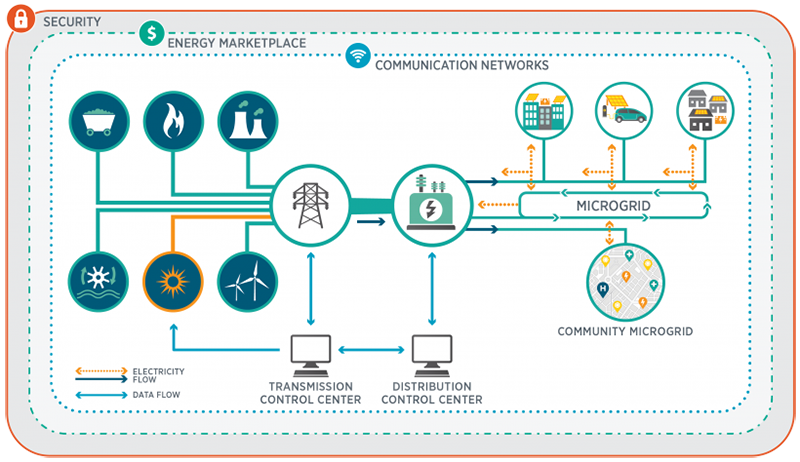
What Are Grid Planning and Operation?
When it comes to systems integration, “planning” refers to near- and long-term power system designs under various generation and load scenarios; “operation” refers to real-time sensing, communication, and control that ensure system reliability. Many organizations work together to maintain the grid’s performance through planning and operation. Private, cooperative, and public utility companies, federal and state agencies, independent system operators, and others work to ensure safe, reliable electricity is delivered to consumers.
The technologies necessary to achieve safe, secure, reliable, and affordable power delivery fall into four categories: balancing, protection, situational awareness, and utility management tools.
Balancing
Balancing is the task of making sure electricity generation matches consumption. The electrical grid is not like a grocery store, where products are stocked on the shelf then sold. Electrical power is generated and then almost instantly consumed by devices in homes and businesses. Therefore, utilities must carefully balance generation, minute to minute, with power that is being used, also known as load.
Consumers change the load when they turn their devices on and off. Generators ramp up and down, and may go offline owing to an equipment fault. With renewables like solar, weather conditions and the daily passage of the sun across the sky introduce additional variability in generation. If there is too much or too little generation to serve the current load, over- or under-generation occurs.
A temporary drop in generation might need to be compensated by ramping up other generators, by reducing load, or by tapping stored energy. Solar can help balance the grid by keeping some generating capacity in reserve. Solar plants can then respond to increasing demand by releasing the power they were holding back. Because a solar plant doesn’t have a lot of mechanical inertia like traditional fossil-fueled turbines, it can respond much more quickly to changes. Solar can therefore provide grid operators with a fast, almost instantaneously available resource to help balance the grid, potentially distributed across millions of homes in an area.
Protection
Protection refers to the use of devices such as relays, breakers, and fuses that protect people and equipment from unsafe electricity. For instance, if a power line is down, creating a condition known as a line-to-ground fault, large amounts of current will flow into the ground. This is dangerous for people near the power line, but it’s also dangerous to electrical equipment that is not designed to carry as much current as the line will carry when it’s lying on the ground. Therefore, automated systems must be installed to disconnect the line quickly when necessary. Effective protection will allow the system to isolate and clear the fault while the rest of the grid remains operational during a disruption.
Distributed energy resources (DER), such as household solar panels, present new challenges to grid protection measures, simply because they provide new sources of generation that need to be monitored and safely disconnected during faults. On the other hand, DER represent a new fleet of smart, connected devices that can serve as gateways for monitoring and control, giving grid operators a new window onto the condition of the grid for identifying problems faster than ever. In addition, because DER produce power where it will be used, communities are better equipped to deal locally with the consequences of failures in the power system.
Situational Awareness

All these issues highlight the need for improved sensing, communications, and control in electrical grids with large amounts of solar generation, especially distributed rooftop solar. Situational awareness refers to the utilities’ awareness of the current load, the current generation, and where that generation and consumption is occurring.
As the electricity system modernizes, the instrumentation and technology required to observe and control it has become more complex. Advanced power electronics and other smart devices in your home can give utilities information so they can better manage loads. Line sensors and other devices on utility poles can provide information on a neighborhood level. Power lines can be equipped with fault indicators, and digital substations can also present important information.
Situational awareness is always important, but it becomes especially important when there is a disaster or an accident that requires a fast, smart response. Historically, utilities have not had fine-grained insight into the distributed grid. For instance, grid operators are unlikely to have access to real-time information about how much electricity individual households are using, nor are they aware of downed power lines unless a customer reports it. In a disaster, understanding where a problem is occurring is the first step to solving it.
Utility Management Tools
To realize the benefits of DER for grid operation, utilities need a way to interface with these generators. That means they need a software platform that allows DER to be seen, managed, and controlled effectively and efficiently while maintaining privacy and security. That’s where a distributed energy resource management system (DERMS) comes in. A DERMS allows a grid operator to securely monitor and control distributed resources and make better decisions about what resources to tap in different situations.
DERMS is an active area of software engineering and research. A good DERMS should be able to deal with demand-response resources (loads the utility can control to reduce demand, like water heaters or smart thermostats), distributed generation (such as solar), electric vehicles, and energy storage (like batteries). It should also be aware of grid conditions so that decisions can be made based on real-time power flow. Building a software platform that allows operators and DER aggregators to conduct this orchestra of energy resources is difficult, but it can lead to more efficient, cleaner, and more cost-effective grid operation.






